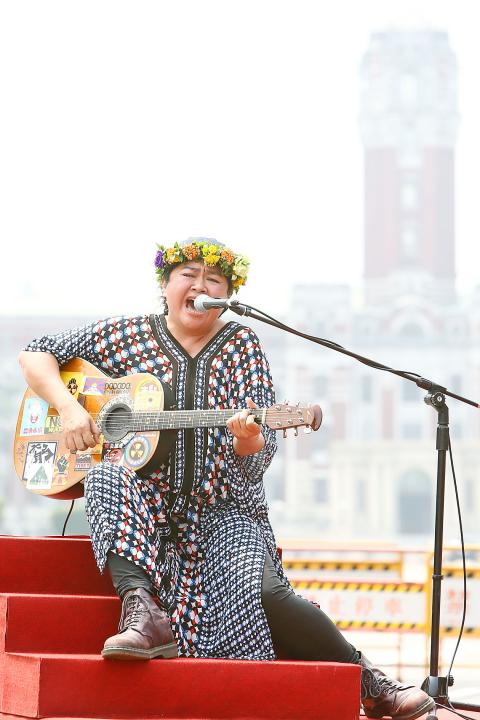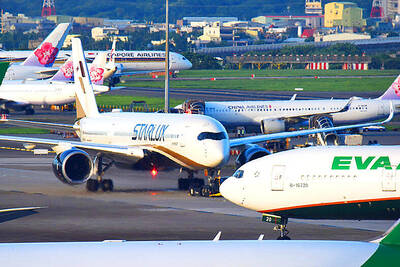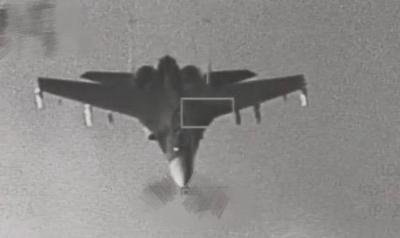Aboriginal rights campaigner Panai Kusui and other advocates yesterday relocated dozens of potted lilies from their protest site at the 228 Peace Memorial Park to an art museum as the Taipei City Government prepares to demolish their camp next week.
After the government announced the Guidelines for Demarcating Aboriginal Land or Tribal Areas (原住民族土地或部落範圍土地劃設辦法) in February 2017, Panai and other advocates camped on Ketagalan Boulevard, in front of the Presidential Office Building, in protest and were later forced to move to the nearby park.
The guidelines restrict Aboriginal domains to government-owned plots and exclude areas owned by private landowners, enabling businesses to launch controversial development projects on Aboriginal land, such as the Miramar Resort Hotel (美麗灣渡假村) project, advocate Liao Hsing-yu (廖幸渝) said yesterday.

Photo: Chen Yi-kuan, Taipei Times
Under the slogan “No one is an outsider,” the campaigners yesterday had camped in the area for 696 days, Liao said.
However, the municipality has said that it would remove their belongings on Tuesday, she said.
The government might have timed the removal to take advantage of the absence of other key campaigners, such as filmmaker Mayaw Biho and singer Nabu Husungan Istanda, who have left for other events, she added.
RELOCATION
The activists yesterday invited members of the public to help them relocate some of the nearly 300 pots of Taiwanese indigenous lily sprouts to the Taipei Fine Arts Museum, where they have an exhibition area at the Taipei Biennial, which this year is titled Post-Nature — A Museum as an Ecosystem and ends on March 10.
Lilies are a sacred symbol for the Rukai people and campaigners from different Aboriginal communities have expressed the hope that they could return home by the time the plants blossom.
VITALITY
Taiwanese indigenous lilies are full of vitality and people who care for them should not rush to weed their pots, Panai said, before transporting some of the lilies by MRT along with nearly 20 participants.
The Democratic Progressive Party government has defended Taiwanese dignity in the face of Chinese pressure, yet it is insensitive toward the pain of Aborigines, who were deprived of their ancestral lands, languages and cultures, she said in a previous TV interview.
She added that she would continue to fight for Aborigines’ rights and raise public awareness about their predicament.

Trips for more than 100,000 international and domestic air travelers could be disrupted as China launches a military exercise around Taiwan today, Taiwan’s Civil Aviation Administration (CAA) said yesterday. The exercise could affect nearly 900 flights scheduled to enter the Taipei Flight Information Region (FIR) during the exercise window, it added. A notice issued by the Chinese Civil Aviation Administration showed there would be seven temporary zones around the Taiwan Strait which would be used for live-fire exercises, lasting from 8am to 6pm today. All aircraft are prohibited from entering during exercise, it says. Taipei FIR has 14 international air routes and

Taiwan lacks effective and cost-efficient armaments to intercept rockets, making the planned “T-Dome” interception system necessary, two experts said on Tuesday. The concerns were raised after China’s military fired two waves of rockets during live-fire drills around Taiwan on Tuesday, part of two-day exercises code-named “Justice Mission 2025.” The first wave involved 17 rockets launched at 9am from Pingtan in China’s Fujian Province, according to Lieutenant General Hsieh Jih-sheng (謝日升) of the Office of the Deputy Chief of the General Staff for Intelligence at the Ministry of National Defense. Those rockets landed 70 nautical miles (129.6km) northeast of Keelung without flying over Taiwan,

City buses in Taipei and New Taipei City, as well as the Taipei MRT, would on Saturday begin accepting QR code payments from five electronic payment providers, the Taipei Department of Transportation said yesterday. The new option would allow passengers to use the “transportation QR code” feature from EasyWallet, iPass Money, iCash Pay, Jkopay or PXPay Plus. Passengers should open their preferred electronic payment app, select the “transportation code” — not the regular payment code — unlock it, and scan the code at ticket readers or gates, General Planning Division Director-General Liu Kuo-chu (劉國著) said. People should move through the

The Ministry of National Defense (MND) today released images of the military tracking China’s People's Liberation Army (PLA) movements during the latest round of Chinese drills around Taiwan. The PLA began "Justice Mission 2025" drills today, carrying out live-fire drills, simulated strikes on land and maritime targets, and exercises to blockade the nation's main ports. The exercises are to continue tomorrow, with the PLA announcing sea and air space restrictions for five zones around Taiwan for 10 hours starting from 8:30am. The ministry today released images showing a Chinese J-16 fighter jet tracked by a F-16V Block 20 jet and the